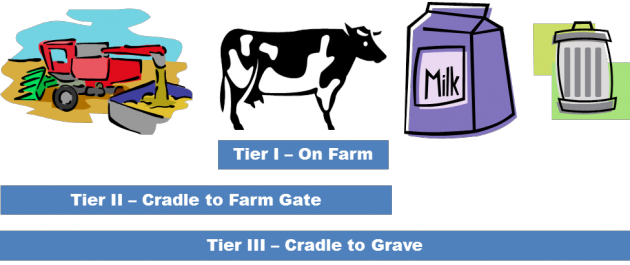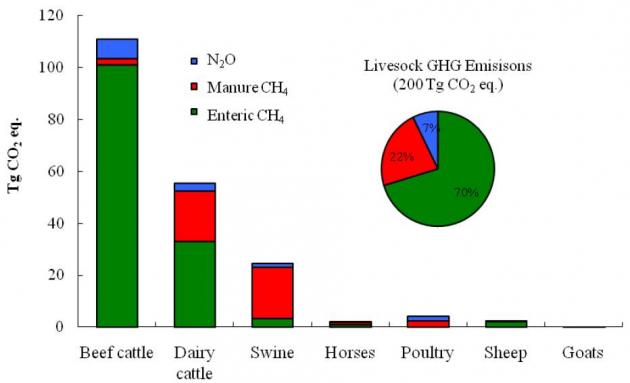The conversation about climate change largely revolves around greenhouse gases. Agriculture is both a source and sink for greenhouse gases (GHG). A source is a net contribution to the atmosphere, while a sink is a net withdrawal of greenhouse gases. In the United States, agriculture is a relatively small contributor, with approximately 8% of the total greenhouse gas emissions, as seen in Figure 1.
Most agricultural emissions originate from soil management, enteric fermentation (microbial action in the digestive system), energy use, and manure management (Figure 2). The primary greenhouse gases related to agriculture are (in descending order of magnitude) methane, nitrous oxide, and carbon dioxide.
Fact sheet: Contribution of Greenhouse Gases: Animal Agriculture in Perspective (look below the preview box and title for a download link)
 |
Figure 1: U.S. greenhouse gas inventory with electricity distributed to economic sectors (EPA, 2013) |
|
|
Figure 2: U.S. agricultural greenhouse gas sources (Adapted from Archibeque, S. et al., 2012) |
Animal Agriculture’s Contribution to Greenhouse Gas Emissions
Within animal production, the largest emissions are from beef followed by dairy, and largely dominated by the methane produced in during cattle digestion (Figure 3).
|
|
Figure 3: Greenhouse gas emissions from livestock in 2008 (USDA, 2011) |
Excess nitrogen in agriculture systems can be converted to nitrous oxide through the nitrification-denitrification process. Nitrous oxide is a very potent greenhouse gas, with 310 times greater global warming potential than carbon dioxide. Nitrous oxide can be produced in soils following fertilizer application. This includes both commercial, inorganic fertilizer as well as organic fertilizers like manure or compost.
As crops grow, photosynthesis removes carbon dioxide from the atmosphere and stores it in the plants and soil life. Soil and plant respiration adds carbon dioxide back to the atmosphere when microbes or plants breakdown molecules to produce energy. Respiration is an essential part of growth and maintenance for most life on earth. This repeats with each growth, harvest, and decay cycle, therefore, feedstuffs and foods are generally considered to be carbon “neutral.”
Some carbon dioxide is stored in soils for long periods of time. The processes that result in carbon accumulation are called carbon sinks or carbon sequestration. Crop production and grazing management practices influence the soil’s ability to be a net source or sink for greenhouse gases. Managing soils in ways that increase organic matter levels can increase the accumulation (sink) of soil carbon for many years.
Enteric Fermentation
The next largest portion of livestock greenhouse gas emissions is from methane produced during enteric fermentation in ruminants – a natural part of ruminant digestion where microbes in the first chamber of the stomach, the rumen, breaks down feed and produces methane as a by-product. The methane is released primarily through belching.
As with plants, animals respire carbon dioxide, but also store some in their bodies, so they too are considered a neutral source of atmospheric carbon dioxide.
Manure Management
A similar microbial process to enteric fermentation leads to methane production from stored manure. Anytime the manure sits for more than a couple days in an anaerobic (without oxygen) environment, methane will likely be produced. Methane can be generated in the animal housing, manure storage, and during manure application. Additionally, small amounts of methane is produced from manure deposited on grazing lands.
Nitrous oxide is also produced from manure storage surfaces, during land application, and from manure in bedded packs & lots. Related: Archived webinar on GHG Emissions Research in Animal Ag
Other sources
There are many smaller sources of greenhouse gases on farms. Combustion engines exhaust carbon dioxide from fossil fuel (previously stored carbon) powered vehicles and equipment. Manufacturing of farm inputs, including fuel, electricity, machinery, fertilizer, pesticides, seeds, plastics, and building materials, also results in emissions.
To learn more about how farm emissions are determined and see species specific examples, see the Carbon Footprint resources.
To learn about how to reduce on-farm emissions through mitigation technology and management options, see the Reducing Emissions resources.
Carbon Footprint
Definition: carbon footprint is the total greenhouse gas emissions for a given person, place, event or product.
Carbon footprints are created using a process called life cycle assessment. Life cycle assessment or LCA is a method of resource accounting where quantitative measures of inputs, outputs and impacts of a product are determined.
Life cycle assessment is commonly used to:
- find process or production improvements
- compare different systems or products
- find the ‘hot spots’ in a product’s life cycle where the most environmental impacts are made
- help businesses or consumers make informed sourcing decisions

Key Assumptions
boundaries of the system: each higher tier provides a more complete picture of the product’s impacts, however requires more time and resources to complete.
- Gate to Gate (LCA Tier I) – inventories the direct emissions for a single product of process
- Cradle to Gate (Tier II) – inputs are taken back to the initial extraction as natural resources up to a certain point in the product’s life such as its sale from the farm, i.e. farm gate. This will include both direct and indirect emissions from the product.
- Cradle To Grave (Tier III) – the product is followed through the consumer to its eventual recycling or disposal.
Sources of variation
Different researchers may get different results when performing a LCA on the same product. This can happen for many reasons:
- System boundary definition
- Inclusion/exclusion of secondary/ indirect sources
- Inclusion/exclusion of biogenic carbon (stored in organisms)
- Inclusion/exclusion of carbon dioxide from fuel combustion
- Functional relationships used
- Global warming potential indexes
- Inclusion/exclusion of carbon sequestration
Related: Six archived webinars on the sources of animal ag ghg’s (some are general and some are species-specific)
Educator Materials
If you would like to use the video, slides, or factsheet for educational programs, please visit the curriculum page for download links for this and other climate change topics.
Recommended Reading – How Many Greenhouse Gases Does Agriculture Emit?
U.S. Agriculture Emissions
- EPA greenhouse gas inventory updated annually. Use the data explorer to highlight agricultural emissions.
- USDA climate change program
- Agriculture’s Role in Greenhouse Gas Emissions and Capture, ASA, CSSA, SSSA (2010)
-
Beef Sustainability: Where Does Climate Change Fit? View
- Animal ag & GHG materials developed for ag teachers (AFNR cross-referenced) More…
International Agriculture Emissions
- Intergovernmental Panel on Climate Change (IPCC) Fifth Assessment Report (AR5). Chapter on Agriculture
- Livestock’s Long Shadow, FAO report
Carbon Footprints and Life Cycle Analysis
- EPA LCA Resources
- Comet -Farm Colorado State/USDA whole farm or ranch greenhouse gas accounting system
- Are models useful in determining the footprint of pork production?
Greenhouse Gas Regulations for Animal Agriculture
Visit Climate Change Regulation, Policy, and Market Opportunities
Acknowledgements
Author: Crystal A. Powers – University of Nebraska-Lincoln cpowers2@unl.edu
This material was developed through support from the USDA National Institute for Food and Agriculture (NIFA) under award #2011-67003-30206.




